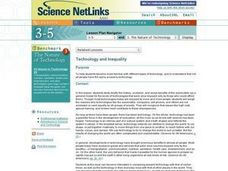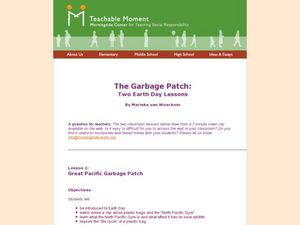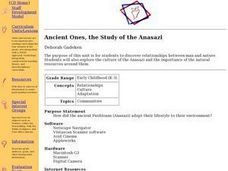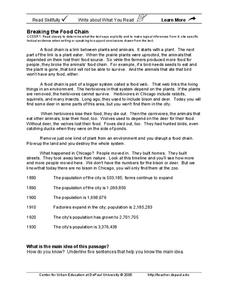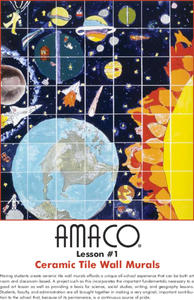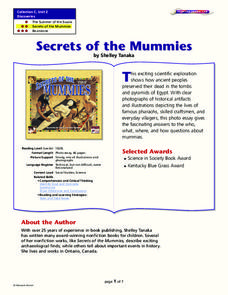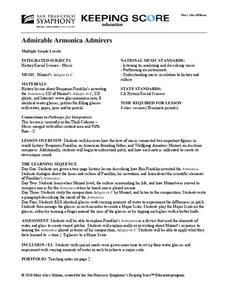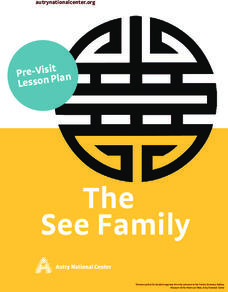Curated OER
Technology and Inequality
Students study briefly the history, evolution, and social benefits of the automobile. After using the automobile as a case study, students choose another technology, research, and analyze it in small groups and report.
Curated OER
Corn: An A--Maizing Plant
Third graders examine the history of corn. In this agriculture lesson, 3rd graders discuss the history of corn and identify the corn belt on a map. Students dissect kernels of corn and discuss their observations.
Curated OER
Reflections of Ancient Greece
Students study ancient Greek civilization. In this World history lesson, students locate Greece on a world map and review what the ancient Greeks did when they developed new ideas for government, science, philosophy, religion,...
Curated OER
Loco for Cocoa
Third graders research the history of cocoa. In this cocoa lesson, 3rd graders investigate how the cocoa bean has been traded from one country to another. Students create a timeline and map to track the history of the cocoa bean.
Curated OER
Telling Time Timeline
Use the Internet and library resources to compose a telling time timeline -- a visual history of time. Students will develop research skills and gain perspective about telling time by discovering the history of clocks and time.
Curated OER
Just "Kid"ding Around: The Truth About Goats
Students examine goats, and read a book based on their history. In this animal lesson, students discover the history of the goat, and complete several activities based on the students' knowledge of the animal.
Curated OER
Mixing It Up!
Third graders identify the different states of matter. In this science lesson, 3rd graders describe the different components of solutions and mixtures. They create emulsions, foams and suspensions in the lab.
Curated OER
1,000 Cranes
Learners improve motor skills through careful folding, a discipline necessary in the practice of origami. They develop multicultural awareness by exploring Japanese history.
National First Ladies' Library
Save the Animals: The Creation of the ASPCA
Students read Black Beauty and study the history of the founding of the ASPCA and learn about endangered species today. Then they write a short paper about the book, or on some aspect of the history of the ASPCA, and, after exploring the...
Curated OER
How Grandmother Spider Stole the Sun
Students explore U.S. history by reading a Native American tale in class. In this cultural storytelling lesson, students read the story How Grandmother Spider Stole the Sun and discuss the characters and themes of the Native American...
Curated OER
The Garbage Patch: Two Earth day Lessons
Students view a seven minute video called Gorilla in the Greenhouse. In this Earth day lesson, students review the history of Earth day. Students work in groups to describe the life cycle of a plastic bag. Students understand that...
Curated OER
City Life or Desert Life
Learners study the Anza-Borrego Desert. They complete the Patterns Project and survey the history of San Diego. They present their research to the class in the form of poster or report.
Curated OER
Rice Farming in Texas
Third graders explore how rice farming came to Texas. In this rice farming lesson, 3rd graders discover the history of how farmers began to grow rice in the United States. Students color code maps and create a timeline for rice farming...
Curated OER
Ancient Ones, the Study of the Anasazi
Young scholars explore relationships between man and nature. They examine the culture of the Anasazi and the importance of the natural resources around them. Students examine reasons for Anasazi people to leave this area.
DePaul University
Breaking the Food Chain
Throughout history, the growth of big cities has resulted in the destruction of ecosystems. In the case of Chicago, IL, a grassland that was once home to bison, deer, wolves, and foxes quickly became a booming city of over three million...
American Art Clay Co., Inc.
Ceramic Tile Wall Murals
Science, social studies, language arts, and art classes work together with administrators to produce a permanent, ceramic tile wall mural to install at their school.
Curated OER
Secrets of the Mummies
How did the ancient people of Egypt preserve their dead so well that their bodies are still recognizable today? Learn the painstakingly complex process they used for preservation. Young scholars read and summarize a narrative detailing...
Lesson Planet
Celebrate Native American Heritage Month with Earnest Research
Incorporating research and project-based learning while celebrating Native American Heritage Month.
Curated OER
Math for the Frontier
Make history come to life by using the Frontier House series to engage learners in the past. Your class will "prepare" for a trip to 1833 Montana. They will learn about homesteading, frontier life, inflation, and cost of living. Using...
Curated OER
N is for Natural State
For any pupils who live in the state of Arkansas, this would be a fabulous educational experience to help them get to know their state better. Through the use of activities in literature, art, mathematics, science, social studies, and...
Museum of Tolerance
Where Do Our Families Come From?
After a grand conversation about immigration to the United States, scholars interview a family member to learn about their journey to America. They then take their new-found knowledge and apply their findings to tracking their family...
San Francisco Symphony
Admirable Armonica Admirers
What do Ben Franklin and Wolfgang Mozart have in common? Find out about the musical invention, the armonica or glassy-chord. Learners will read about how Ben Franklin invented this new instrument and how Wolfgang Mozart came to play it....
Curated OER
About Life: The Photographs of Dorothea Lange
Young scholars use art to analyze a period in history. In this lesson about the effect of art on history, students study many different pieces of photography by Dorothea Lange. Young scholars will observe photographs from certain time...
Curated OER
The See Family
Third graders examine photographs as primary source documents. Students are broken into groups and are given photographs of the See Family.
